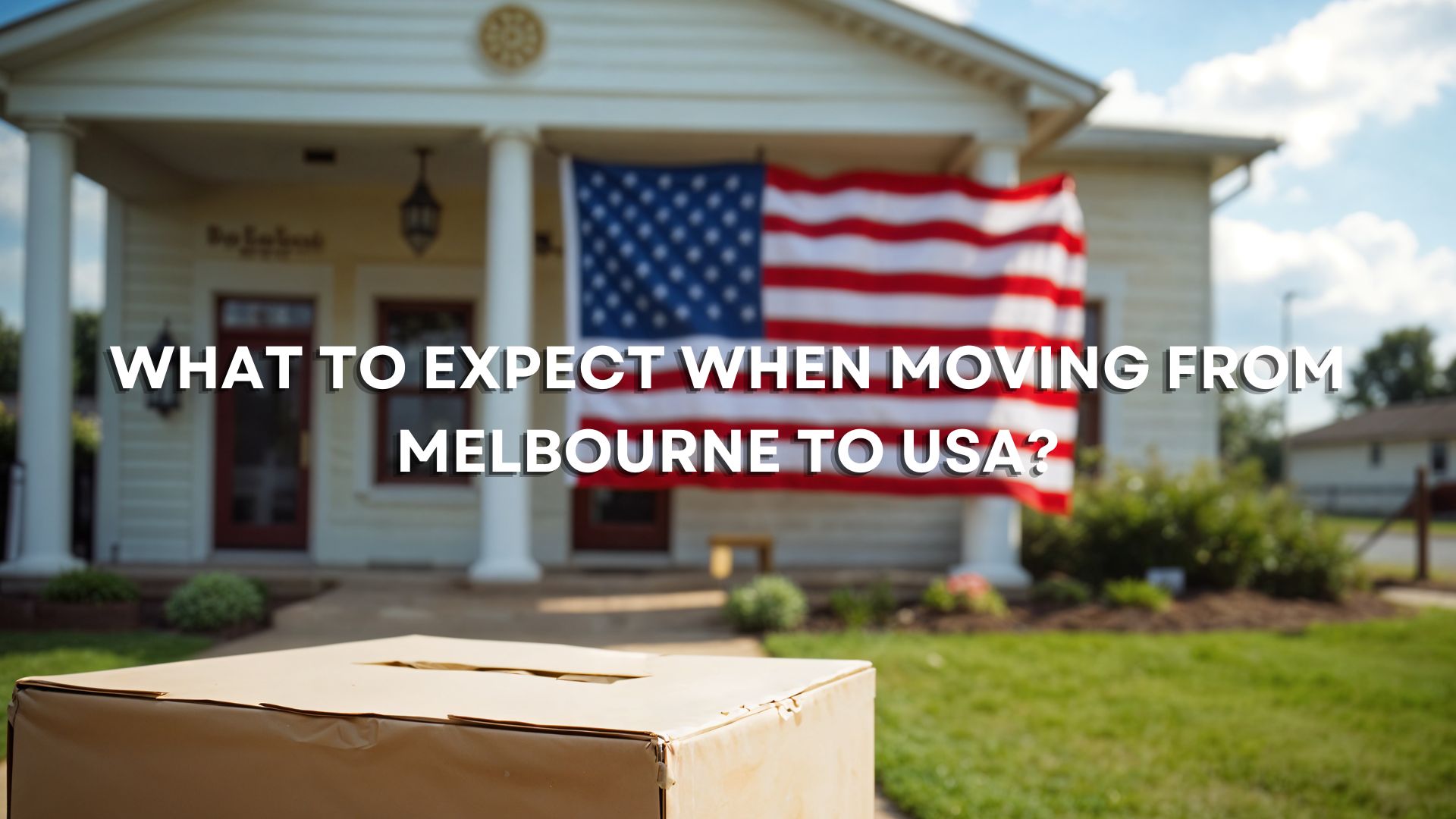Moving from one home to another home is a hassle. Now imagine moving from one city to another city. It’s such a troublesome thing, and we know it. How? Well, we have all been there. Cause we all need to move once in a lifetime. If the talk is about moving from Melbourne to the USA, then the hassle increases even more.
You need to know you can come hitting your face. Otherwise, the hit can make you fall. To Save yourself from falling, learn what to expect when moving from Melbourne to USA.
What to Expect When Moving from Melbourne to USA?
Cost of living
The average cost of living in the United States ranges from $2,500 to $3,500 per month, influenced by location and lifestyle. This estimate encompasses housing, food, transportation, healthcare, taxes, and other expenses.
Here's a breakdown of average costs:
- Housing: $1,784 per month (34.9% of total spending)
- Transportation: $9,826 per year (16% of total spending)
- Healthcare: $5,177 per year
- Food: $7,317 per year (approximately $609.75 per month)
- Utilities: $370.16 per month
On the other hand,
The cost of living in Melbourne for a single person typically ranges from USD 1,900 to USD 2,400 per month, though this can vary based on individual spending habits and lifestyle choices. Here’s a breakdown by category:
Category | Student | Single | Family |
Housing/Rent | $800 - $1,200 (shared apartment) | $1,200 - $1,500 | $2,000 - $2,500 |
Utilities | $50 - $100 | $100 - $120 | $200 - $300 |
Groceries | $150 - $200 | $200 - $300 | $500 - $800 |
Transportation | $100 - $120 | $150 - $350 | $500 - $800 |
Health Insurance | $50 - $80 | $50 - $80 | $200 - $300 |
Other (entertainment, shopping, personal care) | $100 - $200 | $200 - $250 | $300 - $500 |
Moving from Melbourne to the USA can bring a noticeable shift in the cost of living. The USA is more expensive than Melbourne. So, keep that in mind before moving.
Visa requirement
When moving from Melbourne to the USA, there are some facts you should know about. In those visa requirements will depend on the purpose and duration of your stay. Here are the main visa categories:
- Tourist/Business Visa (B-1/B-2): For short-term visits, usually up to 6 months, for tourism, business meetings, or family visits. Not for working or studying.
- Work Visa (H-1B, L-1, etc.): If you're moving for employment, you'll need a work visa. The H-1B is for skilled workers, while the L-1 is for company transfers. These visas usually require employer sponsorship.
- Student Visa (F-1): If you're moving to study, you’ll need an F-1 visa. An accredited U.S. institution must accept you before applying.
- Permanent Residency (Green Card): For those intending to stay long-term, applying for a Green Card through family, employment, or a diversity lottery is an option, though it can take years.
As processing times vary, ensure you apply for the appropriate visa well in advance. Each visa has specific requirements, so research thoroughly before beginning the application process.

Cultural Differences
Australians tend to be more laid-back, while Americans, particularly in fast-paced cities, often focus more on career and productivity. Their sense of humour also differs. Aussies appreciate dry, sarcastic wit, whereas Americans may lean toward more direct humour.
Patriotism is strong in the U.S., with a YouGov survey showing that 41% of Americans believe their country is the best in the world. This deep sense of national pride is something you’ll encounter regularly.
Another noticeable shift is the approach to social interactions. In Australia, conversations often include self-deprecating humour and casual small talk, while Americans can be more expressive and enthusiastic, focusing more on individual achievements.
So, be aware or make yourself like that before moving out.
Climate Variations
When moving from Melbourne to the USA, be prepared for significant climate variations depending on where you settle. Melbourne’s temperate climate, with its famously unpredictable "four seasons in one day," contrasts with the wide range of climates in the U.S.
In the northeast, cities like New York and Boston experience hot, humid summers and cold, snowy winters. The southern states, like Florida and Texas, have a subtropical climate with long, hot summers and mild winters.
If you move to the Midwest, brace for extreme seasonal shifts—sweltering summers and bitterly cold winters. Meanwhile, California offers more of a Mediterranean climate, similar to Melbourne, with mild, wet winters and dry summers.
Adapting to these variations is key, and your wardrobe may need a significant update depending on your destination!
Lifestyle change
One of the biggest shifts when moving from Melbourne to the USA is the lifestyle change. Melbourne is known for its laid-back vibe, vibrant arts scene, and coffee culture.
If you like East Boston's distinct style and vibe, shaped by its rich history and cultural diversity, then it would be pretty hard to adjust here.
Adjusting to a more car-centric lifestyle may take time. Socially, Americans can come across as more direct. However, their friendliness is often expressed differently, especially in places known for hospitality like the South. Expect a shift in daily routines, from how people socialize to how they navigate their neighbourhoods.
Say Goodbye To Free Healthcare
Australia’s Medicare system is highly regarded, providing full coverage for in-patient care and up to 75% for services like physiotherapy. When relocating to the U.S., however, you’ll encounter a very different healthcare model. The U.S. operates on a privatized system, meaning citizens and visitors alike have to pay for every medical service. For instance, something as simple as breaking a leg could leave you with a bill of around $7,500.
To manage this, it's essential to prioritize preventive care and wellness. Regular check-ups with trusted providers such as Complete Health Birmingham AL can help you maintain good health and catch potential issues early, reducing the financial impact of costly medical treatments. Additionally, learning how U.S. health insurance works and finding the right plan is key to easing the burden of healthcare expenses. Many expats are often shocked by the complexity and costs, so preparation is vital.
A Gun Is No Big Deal
While Australia has strict gun control laws and a cultural perspective that generally views firearms as dangerous, many Americans see gun ownership as a fundamental right protected by the Second Amendment.
Nearly 250 years ago, Americans were granted "the right to keep and bear arms," which remains firmly held today. The level of gun ownership in the U.S. is astonishing, with approximately 90 firearms for every 100 people. Many Americans equate unrestricted access to guns with total freedom, making the push for stricter gun control measures a challenging endeavour.
If you see someone holding a gun, don’t run away. It may be his hobby.
Conclusion
What to Expect When Moving from Melbourne to USA?
Moving from one home to another home is a hassle. Now imagine moving from one city to another city. It’s such a troublesome thing, and we know it. How? Well, we have all been there. Cause we all need to move once in a lifetime. If the talk is about moving from Melbourne to the USA, then the hassle increases even more.
You need to know you can come hitting your face. Otherwise, the hit can make you fall. To Save yourself from falling, learn what to expect when moving from Melbourne to USA.

